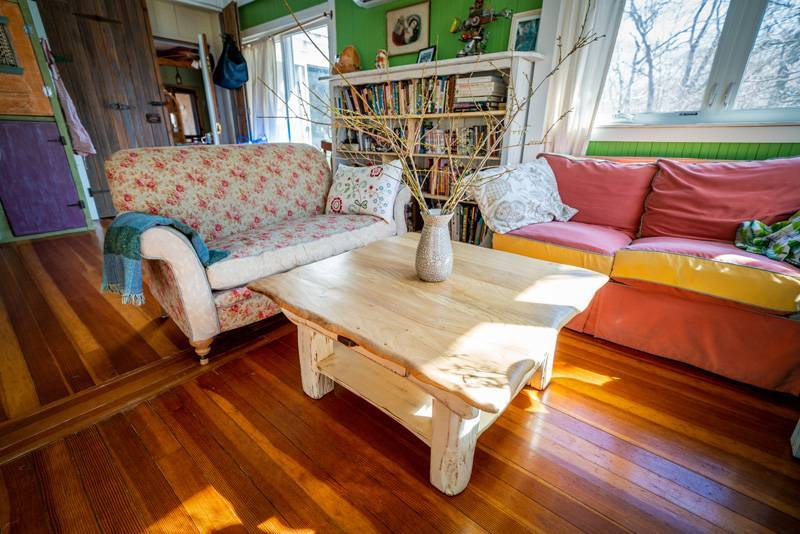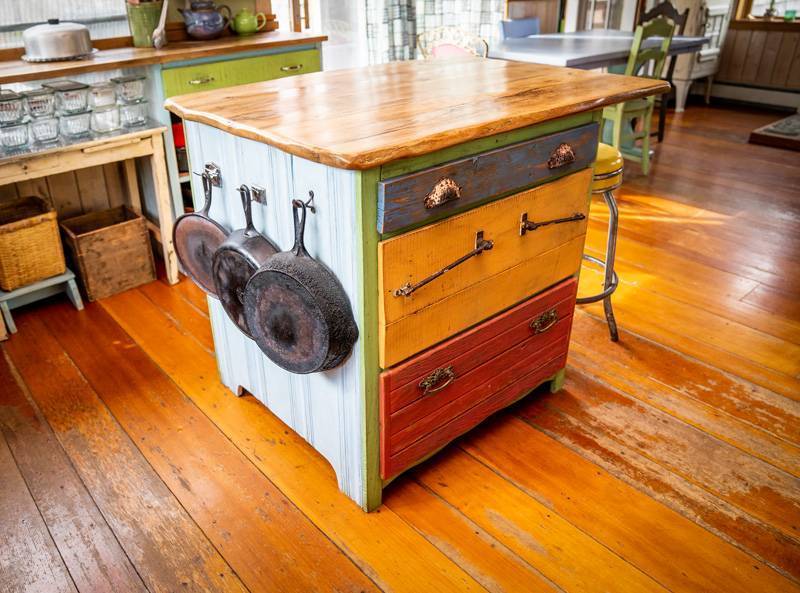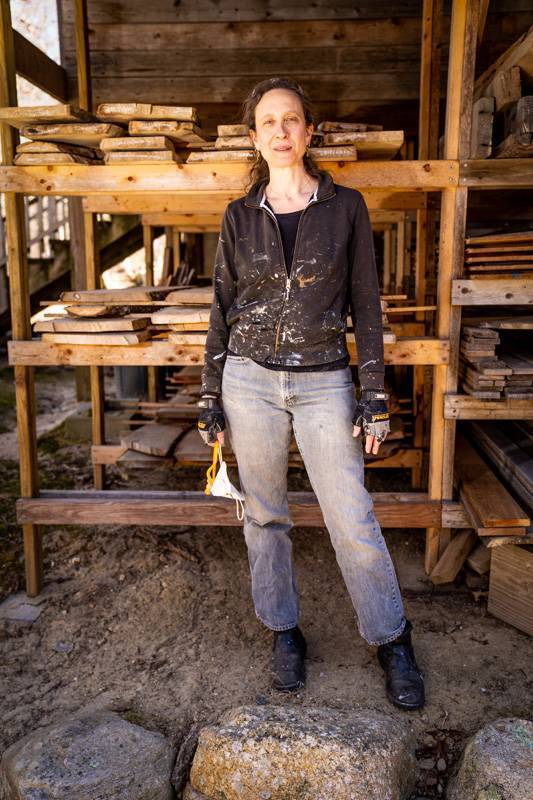On a snowy day in February, Demolition Revival Furniture’s Laura Silber is Zooming from her kitchen. She is surrounded by things she has made: the house itself, the bright green walls she has painted, the reclaimed fir floors with their hand-sanded seams, the stone fireplace built with the rocks friends were asked to bring as donations when they came for dinner, the narrow, eight-foot-tall apricot hutch (her first piece of furniture), mirrors, catalpa cheese boards.
Laura has had a busy few months. She is the new coalition coordinator for the Coalition to Create the Martha’s Vineyard Housing Bank, which she says, “is an honor. And it’s in my wheelhouse. I like participating in the legislative process. I like understanding the mechanics of how things work. With this, it’s pulling the veil back to see how our government functions, and gaining a deeper understanding of our society’s needs.” She laughs, “And balancing all this amid the personal dynamics of a community. It is fascinating to me.”
Laura is not new to community leadership — she is one of the founding members of We Stand Together/Estamos Todos Juntos! and has been very active with the Martha’s Vineyard Island Parents Advisory Council on Special Education for six years. Of course, this work happens outside the hours when she is cooking for families, making furniture for others, and being a mom to her son Isaac, who is 16.
As you already know, or maybe are learning, Laura goes by many names here: chef, woodworker, mother, advocate, artist, community organizer. And she has made a life here on the Island constructing beautiful food, furniture, and new formulas for thinking about community. It’s an extraordinary collage of skills and cognitive abilities.
When she thinks about where this came from, she says, “Some of it is just me. I have always been someone who evaluates the way things work and questions the way we do things. In my teens, I became aware of the climate crisis — science was talking about it in the ’80s — and was bothered by American consumerism. I saw plastic everywhere. I stopped using straws, and [started] carrying my own grocery bags.
“I also credit my mom for not buying me an Easy-Bake Oven, which, when I was 5, I was absolutely desperate to have. She refused, saying, ‘No child of mine will learn to cook with a lightbulb.’”
“But some of the critical thinking and my sense of thrift are definitely from my family. No one wasted anything — food, materials, clothes. My mom taught me to sew early on. And there is something in that experience of understanding how to construct a garment that informs so much of what I do today.” She laughs, “I still like to see clothes where the seams are highlighted — how they’ve brought the fabric together with a particular stitch. I also credit my mom for not buying me an Easy-Bake Oven, which, when I was 5, I was absolutely desperate to have. She refused, saying, ‘No child of mine will learn to cook with a lightbulb.’ If she had gotten me one, I honestly don’t know if I’d have pursued any kind of training to be a chef, or even be living here.”

Laura grew up amid dairy farms in the small hamlet of Glenmont, N.Y., which is just south of Albany in the Hudson River Valley. Her father was a labor lawyer, and her mother a nurse. Her parents, both retired now, still live there. Her father also co-owned a model train shop, which she used to work at on the weekends for her allowance. And her grandfather George was always modifying things, from bikes to the house’s plumbing. He co-founded Rek-O-Kut with his brother, which in its heyday was the hi-fi record player. She remembers, “He was always ‘fixing’ something. My grandparents and aunts and cousins all had places near Lake Mahopac, N.Y. I come from a big family, and everyone would go there in the summer. A big part of that experience was the food. My family was full of good cooks, and we’d have these incredible meals. Huge meals.” Laura stretches her arms out to emphasize the size and number of people at the table, and laughs again. “The doors would open, and cousins, neighbors, friends, would all come in and sit down together. It was joyous.”
As Laura tells it, food was her first love. When she graduated early from high school, she worked as a baker at a gourmet food store near her house: “I loved it. But I also valued higher education. So I chose to go to a four-year college.”
At Northwestern, Laura studied French, comparative literature, and theater, and then moved with “25 friends to West Hollywood.” She wanted to give acting a shot, but was not interested in getting an entry-level job. As fate would have it, within three days of moving to L.A., LA Gourmet hired her as an executive chef. “It really was a right-place, right-time moment. A ridiculously good opportunity,” she remembers. “I had some experience with macrobiotic cooking, and could talk to clients and customers.” Within a year, some of her gang of 25 began to find real Hollywood success, but Laura had rediscovered the kitchen. She was offered a “huge food job,” but turned it down because she wasn’t ready. Instead, in 1991, she moved to Martha’s Vineyard to work for Michael Brisson at L’Etoile: “I wanted to work for someone who was not just a great chef, but is also a great pastry chef. Michael is equally talented at both. I learned so much from him.”
Laura worked for Michael for three years, while throwing pots and keeping the books for Geoffrey Borr’s Chilmark Pottery in the winters: “It was such a great time. In the winter, we’d throw pots, play chess, have potluck dinners. I think I paid $150 a month, and was making $400 a week. I could afford to try things. There was a great freedom in that. This community made it possible for me to not just buy land and build my own home and a business, but also to explore who I wanted to be. Those days are unfortunately over. The housing crisis here is so severe that it threatens every aspect of infrastructure on the Island — economic, public health, everything. We need a long term regional solution. And I believe the housing bank to be the key piece to that solution.”

Ralph Braun showed Laura how to work with wood. He was like her, she said, in that “he has a thrifty sensibility. He likes working with old stuff.” —Photo by Jeremy Driesen
Through Chilmark Pottery, Laura met her woodworking mentor, Ralph Braun. “He now lives in Thailand. He used to do this really high-end specialty carpentry work here. Such a talented woodworker. When I expressed interest in learning from him, at first, he’d just call me up and say, I need someone to hold the other end of a board for me, can you do it? And I’d say yes. Another time after that he called and said, Are you afraid of heights? I said no.” She laughs: “It turns out I am.”
Bit by bit, Ralph began to show Laura how to work with wood. “He’s like me in that he has a thrifty sensibility. He likes working with old stuff. He spent his early career in Germany working on very old buildings and at least one medieval castle.”
But after three years of working with Michael, Ralph, and Geoffrey, Laura decided she needed a change of scene. A friend from L’Etoile had opened a bakery in Sun Valley, Idaho. She explains, “So I went out to bake bread, ski, and think about what I was going to do with my life. It turns out all I needed to do was figure out what was next.” Next was a job cooking for a celebrity. “I loved it.” After three years, she got tired of living out of a suitcase.
She found a vocabulary with crystal handles, highlighting old hardware, face-mounting antique hinges, steam valves, and antique grates. She found colors: “At first, I was drawn to a colonial palette, but then that evolved to a more ’30s and ’40s look.
So at 29, Laura moved back to the Vineyard, where Ralph encouraged her to buy some land and build a house. “Ralph and I went to look at this kite-shaped property together. There was no road. It was totally overgrown. We were bushwacking our way around it, calling out to each other, looking for the property lines, when I came upon two giant pigs having sex [her property abuts Blackwater Farm]. It was hilarious!” She bought the land.
Laura worked with Ralph and friends in the trades to design and build her 1,200-square-foot home. She has repurposed doors from the original Agricultural Hall — “pulled out of a dumpster,” and floors and screen doors from a gutted bungalow on Abel’s Hill. “I was on an extremely tight budget.”
As Laura worked, she began to refine her woodworking aesthetic, which, like her food, is made from scratch. “I began building furniture for the house because I couldn’t afford to buy it. It also seemed pointless to spend money when I had so much scrap wood to work with.” She found she likes drawer faces that sit on top of the frame more than in a frame (in the same way she likes to see the seams on clothes). She found a vocabulary with crystal handles, highlighting old hardware, face-mounting antique hinges, steam valves, and antique grates. She found colors: “At first, I was drawn to a colonial palette, but then that evolved to a more ’30s and ’40s look. I don’t know if anyone remembers the pale green interior of the Humphreys on State Road in West Tisbury, but I just loved that color. I get all my paint mixed at Island Color. Mixing color is almost a lost art form. Bill was an artist. I could bring in a flower, and he could match it. His daughter Jen is equally talented.” Laura also began to develop her painting techniques: “I like to see the grain, the wood.” She explains that she aims to play the paint off the life the wood has had, and the grain to come through the paint. She also prefers woods where the grain is pronounced — particularly when the wood has been exposed to the elements. She likes sassafras, catalpa, Siberian elm, sycamore maple, sometimes English elm, and, these days, uses the end cuts for her cheese boards. She works with wood miller Tom Turner in Katama, and estimates that she now uses 80 to 90 percent reclaimed wood and building goods on all of her projects.
“I think of my work in terms of geography. How the eye will travel over the piece.” She laughs again. “It’s kind of how I think when I’m cooking. I look at temperature, texture, crispy, fresh, cooked, and how that all plays together.”
Laura credits much of her success with her woodworking to Andrea Rogers, who is the organizer of the Artisans Festival. “My first fair was 17 years ago this spring, and I usually do all the multiday festivals — Memorial Day weekend, Labor Day weekend, Columbus Day weekend. I wouldn’t have Demolition Revival Furniture without the Artisans Festival. Most of my customers have connected with me in some way via the Artisans Fair. And the artisans are very supportive of each other’s work — it’s a really great community of talented people.”
These days, half of Laura’s Demolition Revival work is ready-made and another half is commissioned: “I love the process. People come to me with a storage problem, or want a bathroom vanity, or a place to work. I’m always designing with function first. And I want the piece to last 100, 200 years.” For the most part, Laura still works alone. On big projects, she uses Don E. Turnell of Haven Homes: “He’s just so talented. He has an incredible eye and a real understanding of reclaimed materials.”
This winter Laura has been finishing up a few custom projects, and getting stocked up and organized for the summer. “In some weird way, this slower pace of life suits me,” she says. She describes an organic rhythm of working on the Housing Bank, projects for clients, and cooking. “I never have a bad day in the kitchen, it’s relaxing for me. Food is love, romantic, artistic, essential.” After dinner, she might relax with a cup of tea looking for antique hardware or Victorian grates on eBay. She is always thinking about new ways to use what is available — in her food, life, furniture, and in our community.


